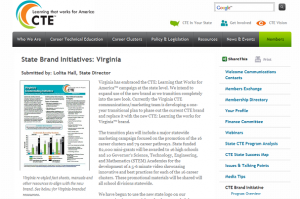Following the State of the Union Address, President Obama spent two days last week touring the country to promote his “Opportunity Agenda,†a program designed to prepare the American workforce for the evolving needs of our economy. On Thursday, McGavock High School, the largest of Metropolitan Nashville Public Schools, played host to the President.
“It was an incredible event that validated the work of so many people here in the city of Nashville,†said Metropolitan Nashville Public Schools (MNPS) Chief Academic Officer Dr. Jay Steele.
Seizing on the President’s assertion that Career Technical Education (CTE) “makes words on a page exciting, real, and tangible†for students, Steele emphasized that the district’s academies are designed to enhance and augment, not supplant, general education. “While CTE is the anchor of the program, core gen ed. courses come alive and become more relevant.â€
Dr. Danielle Mezera, Assistant Commissioner of the Tennessee Department of Education CTE, described MNPS as an “excellent example†of CTE blending with core academic classes to enrich students’ experience.
“Since we came in a couple of years ago, we have really wanted to supply truth in advertising [for state CTE programs,]†Mezera said. “One of our main goals has been to provide the support and flexibility to allow districts to focus on aligning secondary and postsecondary studies with their practical application and with career opportunities. Programs like teacher externships and business partnerships have been key. [MNPS] has done an excellent job taking advantage of them.â€
Even before the Obama Administration announced the visit, MNPS was on the President’s radar. Early in January, the President cited MNPS for overhauling its structure and boosting graduation rates 22 percent.
Yet, MNPS’s place as an exemplar didn’t happen overnight. Rather it took years of sustained effort.
Several years ago, MNPS audited its CTE programs and discovered that they were not as effective as they could be.  MNPS teamed up with the Nashville Chamber of Commerce to comb through workforce data to identify the area’s most in-demand jobs in Nashville. Then, working with the Ford Next Generation Learning Project, Alignment Nashville, the PENCIL Foundation, and local stakeholders, MNPS decided to shift to the career academy model.
The new format promised students the chance to select particular academies of interest (the CMT Academy of Digital Design & Communication or the US Community Credit Union Academy of Business and Finance at McGavock, for instance) in 10th grade. Pairing core academic classes with CTE, students combine what they learn in science, math and language arts with courses teaching career-specific skills.
Speaking about the process, Executive Director of Ford Next Generation Learning Cheryl Carrier said, “You have to have all of the key stakeholders at the table. School districts, business partners, and government have to be at the table together and work towards a common aligned vision. MNPS and the Nashville community were able to create a five-year plan that looked at all aspects of the academy’s development, and it took off.â€
That development led to an innovative CTE program that incorporates all 16 Career Clusters. Seven years into the project, MNPS now also serves as a model for the Ford PAS program, with hundreds of visitors coming each year to observe the academies and devise ways to implement similar models in their districts.
“As the President said, it’s a simple but powerful idea,†Steele said. “It doesn’t require that you change as much as some might think, but it requires you to change the way you think about education.â€
In his remarks during the visit, the President emphasized changing the conversation surrounding education with a similar shift in perspective. “Young people are going to do better when they’re excited about learning, and they’re going to be more excited if they see a connection between what they’re doing in the classroom and how it is applied…Schools like this one teach you everything you need to know in college, but, because of that hands-on experience, schools like this one are able to create pathways so that folks, if they choose not to go to a four-year institution, can get a job sooner.â€
The President’s citation of MNPS and Tennessee’s successful pathways was particularly gratifying for Patrice Watson, Program Manager for Tennessee’s Office of Postsecondary Coordination and Alignment. “Being there and having [the President] talk about giving students different pathways, getting the community involved in the schools, and making [reform] a community effort made it clear that he understands what we’re trying to do here in Tennessee,†she said.
CTE Student Success Career Clusters Consultant Bethany Wilkes agreed that the President’s remarks are an encouraging sign for CTE. “It was incredibly gratifying,†she said. “[The President] focused on how we can develop critical thinking skills and engage the students—that’s what we do every day.â€
The President’s visit to McGavock High came on the same day that the Administration released a fact sheet going more in-depth on its Opportunity for All Agenda. That document, available here, endorses improving alignment between apprenticeships, training programs, and schools, as well as consultation with industry leaders, educators and policymakers to create job-driven training and education. In endorsing McGavock’s CTE-based programs, the President opened the door to making CTE a key component of those efforts.
– Evan Williamson, Communications Associate



